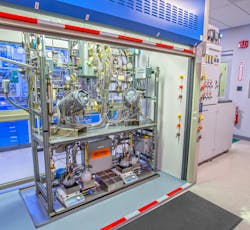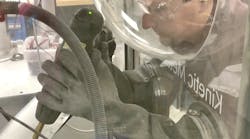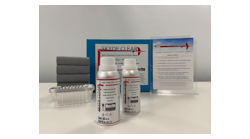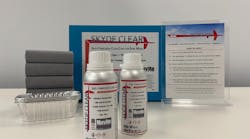Eastman Aviation Solutions is running jet turbine oil through a sophisticated simulator in an attempt to determine the operating margins for the lubricant. The ultimate aim is to develop better aviation oils and — someday— help engine OEMs wring the best performance from their new breed of powerplants.
“It’s about making sure any new oils we design provide maximum protection against deposit formation ensuring key bearings assemblies receive the lubrication and cooling they need for reliable operation — bearings are at the heart of the engine and you don’t want a heart attack!” says Dr. Andrew Markson, head of technology for Kingsport, TN-based Eastman Aviation Solutions.
The simulator is based in Kingsport and is unique and proprietary to Eastman, says Ron Yungk, the turbine manufacturer’s OEM liaison manager. He contends, “There’s nothing which is even closely similar, either in operation or design.”
“It’s actually a fairly large rig,” says Markson. " It’s certainly not portable. It’s housed in a dedicated, environmentally controlled cabinet. Then we have a whole robust series of control systems which monitor many specific variables. Operators can change airflow, temperature and pressure through purposeful control programs," Markson continues.
“I would almost go as far as describing what we have as a test cell,” says Yungk. This distinguishes it from a standard benchtop rig. “This is far from that,” he says. “It’s a substantial piece of equipment, and a huge investment on our part.”
That investment occupies an 8-foot by 5-foot footprint, floor to ceiling. And that’s just the physical set-up, not the attendant control system.
It puts turbine oil through its paces two ways: cyclic performance and thermal margin testing. The former models different phases of flight: taxi, takeoff, cruise descent landing, and taxi-back. The latter entails thermally stretching the oil at a single temperature until it breaks and forms carbon deposits and other sludge materials.
This allows operators, engine OEMs, and Eastman alike to view lubricant performance from a couple of perspectives says Markson: excessive heat soaking back into the oil following sudden engine shutdown or gradual degradation via the rigors of everyday flight operations.
It’s All About Bearings
A basic tenet of turbine engine design, as AMT readers know, is protecting your bearings. “The main issues for bearings, obviously, are heat, stress and wear,” says Markson. “The central [engine] shaft is supported through various bearing assemblies allowing the shaft to rotate freely. An awful lot of stress goes on within that bearing chamber; the metal parts really engage each other. The lubricant can be effective in protecting against any damage or wear through interaction among metal parts.”
In an operational turbine powerplant the lubricant spends a significant fraction of its time as an air/oil mist due to the dynamic environment and elevated temperatures and pressures. What the simulator tries to do is mimic that oil mist lubrication under real world conditions. The hot oil mist circulates around the test chamber before being scavenged away to an oil sump, just as it happens within a real engine.
The JT8D-200 Equation
Those familiar with the once ubiquitous JT8D-200 might understand why Eastman selected that particular engine to model some of the most challenging conditions an aviation oil can encounter. It’s “a difficult engine from a lubrication perspective,” maintains Markson.
That doesn’t mean you can’t run a CFM56 or other powerplant simulation on the rig — just that the Eastman folks believe the JT8D-200 presents the most formidable challenge when it comes to turbine lubricants.
“We’re always looking to evaluate oils under the extreme conditions you’re likely to see,” says Markson. Eastman’s flagship high thermal stability oil, ETO 2197, was designed to be a “problem solver." Running it through the simulator gave the company’s engineers “a very high level of confidence that once the oil saw a real JT8D-200 it would perform better than any other oil out there on the market,” he contends.
Who Benefits and How
The data generated by the simulator “can potentially show an OEM what design margin he has when running our flagship oil vs. some of the standard oils on the market,” says Yungk. More tantalizing perhaps is this: rather than just designing their lubrication systems of the future to operate under what Yungk calls “standard work parameters" … they can extend their [designs] to take advantage of more fuel-efficient conditions — if they’re employing an “oil as thermally stable as Eastman Turbo Oil 2197™.”
The upshot, says Eastman’s OEM liaison: “We can show them just how much more design space they can occupy,” how far the lubricant can go toward wringing out extra miles, added payload, or extended time on wing perhaps.
Dr. Markson agrees. So far, “We’ve operated under certain parameters.” But he quickly adds, “We do have the flexibility with [the simulator] to modify the operating parameters beyond where we’ve currently taken them. That could involve closer collaboration with OEMs on specific engines.” The idea would be to model specific OEM configurations, and associated bearing conditions within the confines of the Eastman simulator.
Markson accedes, “So far, we have only tapped into a portion of the potential for the simulator, but we have the flexibility with the rig to certainly go above and beyond where we currently are.”
Still, this could dovetail nicely with the never-ending trend among jet engine manufacturers to increase the core temperature of their new powerplants. “What this rig does is allow us to push oils to their limits, within [selected] environments,” says Markson.
Ron Yungk adds, “It’s not so much about changing the operation of the oils. It’s more about making sure any new design oils we put together, any new developments provide maximum protection thermally, as well as load carrying.”
To sum up, Eastman says its Aviation Lubricant Advanced Deposition Simulator (ALADS) “allows a ‘true to life’ simulation of engine bearing conditions from a lubrication perspective. It is a lab-based test that evaluates oil through the most challenging phases of aircraft engine operations. The ALADS models the extreme rigors of engine lubrication under various conditions, including full thrust, cruise, and taxiing. Each condition contributes to differential thermal stresses on the lubrication system. This dynamic test allows for a better understanding of oil performance, health, and coking propensity under each condition.”
It’s this ability to “try before you buy” the results of a lubricant that Eastman believes gives it an edge. Seeing the numbers up close and personal can be a compelling piece of evidence.





